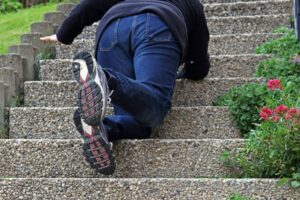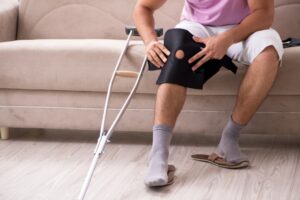Can You Sue if You Get Hurt on Private Property?
Can You Sue if You Get Hurt on Private Property?
Accidents on private property are, unfortunately, an all-too-common occurrence. In many cases, these accidents happen when property owners are negligent and fail to maintain their premises in a reasonably safe condition.
You can take legal action if you suffered injuries on someone else’s private property due to the premises owner’s negligence. In most cases, your attorney can file a personal injury claim with the at-fault property owner’s insurance company. However, if the insurance company denies fault for the accident or refuses to compensate you fairly, your lawyer may file a lawsuit against the negligent owner in a timely manner.
Throughout settlement negotiations or litigation, your premises liability attorney can aggressively advocate for your legal interests to pursue the financial recovery you need.
Schedule a Free Initial Consultation
Duty of Care Owed by a Property Owner

Private property owners owe a legal duty of care to individuals who visit their property, and the extent of this duty varies based on the visitor’s classification at a particular time. The three main categories of visitors are invitees, licensees, and trespassers.
Invitees are individuals invited onto the property for the owner’s benefit, and the property owner owes them a heightened duty of care. This includes maintaining the premises in a safe condition, regularly inspecting for potential hazards, and promptly addressing any potential dangers. The property owner must also take reasonable steps to protect invitees from foreseeable risks.
Licensees – or individuals who enter the property with the owner’s permission for their own purposes – also warrant a high legal duty of care. While this duty is not as stringent as that owed to invitees, property owners are still obligated to warn licensees of any known dangers on the premises. Additionally, if the property owner discovers a hazardous condition, they should either rectify it promptly or provide adequate warning to protect licensees from harm.
Trespassers who enter the property without the owner’s permission generally receive the least protection. However, property owners must still refrain from wanton or intentional misconduct on the premises that may cause injury to trespassers. For example, setting traps or intentionally creating dangerous conditions may bring about legal liability for the property owner.
Regardless of their classification, children often receive special consideration under the attractive nuisance doctrine. Property owners are obligated to exercise reasonable care to prevent harm to children who may be attracted to certain features on the property, such as construction sites or swimming pools. This duty of care arises even if the child is a trespasser.
In fulfilling their duty of care, property owners should regularly inspect the premises, address potential hazards, and provide adequate warnings when necessary. Failure to uphold this duty may result in legal liability for injuries others sustain while on the property.
Types of Incidents that May Occur on Someone Else’s Private Property
Premises accidents on someone else’s private property can encompass a variety of incidents, each posing unique risks to visitors. Slip and fall accidents are among the most common. These may occur due to wet or uneven surfaces, debris, or poorly maintained flooring. Inadequate lighting in stairwells or hallways can also contribute to slip and fall accidents, leading to injuries such as fractures, sprains, or head trauma.
Tripping hazards pose another significant risk, ranging from uneven walkways and loose carpets to cluttered or poorly maintained areas. Property owners must address and rectify these hazards promptly to ensure the safety of those on their premises.
Inadequate security measures can also contribute to various incidents, such as assaults or robberies. Insufficient lighting, malfunctioning security systems, or lack of surveillance may create an environment where criminal activities thrive. Victims of such incidents may hold property owners liable by demonstrating that the lack of security measures directly contributed to the harm suffered.
Dog bites and animal attacks are another category of premises accidents. Property owners with pets are responsible for preventing injuries from their animals. Failure to secure or control a potentially dangerous pet may result in liability for any harm caused to visitors.
Structural defects and poor maintenance can lead to accidents as well. Collapsing ceilings, unstable handrails, or defective staircases may pose serious risks to individuals on the property. Property owners must address structural issues promptly to prevent accidents that may result in severe injuries, including fractures, head injuries, or spinal cord injuries.
Swimming pool accidents are another significant concern, particularly around residential properties. Inadequate fencing, lack of warning signs, or poorly maintained pool areas can contribute to accidents such as drownings or slip and falls. Property owners must implement appropriate safety measures to prevent accidents in and around swimming pools.
While these examples highlight some common types of premises accidents, the specific risks vary depending upon the nature of the property. Property owners have a legal duty to maintain safe premises, address potential hazards, and take reasonable steps to prevent accidents that may harm visitors. If accidents occur due to the property owner’s negligence, they may be liable for the resulting injuries and damages.
Injuries in Premises Accidents
Accidents on someone else’s private property can result in various injuries, depending on the incident’s nature and circumstances. Some of the most common injuries that premises accident victims may suffer include:
- Bone fractures
- Rib fractures
- Soft tissue neck and back injuries
- Bruises
- Open cuts and lacerations
- Concussions
- Infections (such as from dog bites)
- Scarring
- Complete and incomplete paralysis injuries
- Internal bleeding and organ damage
- Mouth and teeth injuries
The specific injuries resulting from accidents on private property are diverse, and the consequences depend on various factors, including the nature of the accident, the condition of the property, and the individuals involved. Seeking prompt medical attention after an accident is crucial to assess and address injuries effectively. If the accident occurred due to the property owner’s negligence, individuals may pursue legal action to seek compensation for their injuries and related damages.
Proving a Premises Accident Claim or Lawsuit
Establishing the property owner’s legal duty of care is a critical first step in a private property premises accident claim. After establishing this duty, the injured party must present certain legal elements of proof to substantiate their claim and demonstrate that the property owner breached their duty, leading to the accident and resulting injuries.
One essential element is establishing the property owner’s awareness or constructive knowledge of the hazardous condition. This involves demonstrating that the property owner either knew about the dangerous condition or, in the case of constructive knowledge, should have known about it through reasonable inspections. Evidence may include prior complaints, maintenance records, or any other information indicating the property owner was aware of the hazardous condition or defect.
Proving causation is another crucial element. The injured party must establish a direct link between the property owner’s breach of duty and the injuries the property visitor sustained. This requires demonstrating that the hazardous condition directly led to the accident and subsequent harm. Medical records, expert testimony, and other evidence can help establish this causal connection.
The foreseeability of the risk is also a key element in a premises liability claim. The injured party must show that a reasonable person in the property owner’s position should have foreseen the potential harm resulting from the hazardous condition. This involves considering factors such as the location of the hazard, the property’s use, and the likelihood of accidents occurring on the premises.
Documenting the extent of the injuries and damages is crucial. Medical records, bills, and expert testimony may be available to establish the severity of the accident victim’s injuries, the need for medical treatment, and the financial effect resulting from the accident.
Witness statements, photographs, and any available video footage can further support the injured party’s case by providing a detailed account of the accident and the hazardous condition. Building a comprehensive case with these legal elements of proof is essential for a successful premises liability claim, ensuring that the injured party has a strong foundation to seek compensation for their injuries and related losses.
Premises Accident Litigation
During litigation in a private property premises accident case, the legal process unfolds in a series of stages to resolve the dispute and determine liability for the injuries the accident victim suffered.
The initial phase involves filing a complaint, outlining the injured party’s claims against the property owner. This legal document sets the foundation for the case, detailing the allegations, the duty of care that the property owner owed, the breach of duty, and the resulting damages.
After filing the complaint, the property owner responds with an answer, presenting their defenses and addressing the accident victim’s allegations. The exchange of legal documents initiates the discovery phase, where both parties gather evidence to support their respective positions. This may involve document requests, written interrogatories, and depositions.
Depositions play a crucial role in obtaining sworn statements from witnesses, experts, and parties involved, allowing each side to gather information and assess the strength of the case. Additionally, the parties may engage in settlement negotiations or alternative dispute resolution (ADR) methods, such as mediation or settlement conferences, to explore the possibility of reaching an agreement without going to trial.
The case proceeds to trial if there is no resolution through negotiation or alternative means. Both parties present their evidence, witness testimonies, and legal arguments during the trial before a judge or jury.
Upon reaching a verdict, the court issues a judgment outlining the legal responsibilities of each party. If the injured party prevails, the judgment may include an award of damages to compensate the accident victim for their injuries and losses.
Throughout the litigation process, legal representation is crucial to navigate the complexities of the case, present a compelling argument, and advocate for the injured party’s rights in seeking fair compensation for the private property premises accident.
Recovering Damages
The law cannot turn back time and stop your injuries from happening. To provide legal relief, the law requires liable parties (usually through their insurance companies) to compensate injury victims with monetary damages.
Recovering damages for injuries on private property involves filing formal insurance claims or lawsuits. The legal process requires careful documentation, legal representation, and establishing a clear connection between the property owner’s negligence and the harm incurred.

First, seeking prompt medical attention is essential. Documenting the extent of injuries through medical records, bills, and expert evaluations is crucial for building a strong case. This establishes a direct link between the premises accident and the resulting physical harm.
Engaging legal representation becomes vital in pursuing favorable damages. An experienced personal injury attorney can assess the accident’s circumstances, evaluate the property owner’s duty of care, and gather evidence to support the claim. They can then guide the injured party through the legal complexities, skillfully addressing all the necessary legal elements in the case.
Proving negligence is a key aspect of recovering damages. After establishing the legal elements of the case, the accident victim may be entitled to various types of economic and non-economic damages, including compensation for related medical treatment expenses, lost income, loss of earning capacity, loss of life enjoyment, loss of use of a body part, loss of spousal consortium, pain and suffering, mental anguish, and other related costs.
Demonstrating the financial and emotional effects of the injuries is crucial when obtaining fair compensation for injuries. Throughout this process, the injured party relies on their premises accident attorney to advocate for their legal rights, present a compelling case, and navigate the complexities of recovering damages for the injuries they suffered in their premises accident on private property.
Speak with an Experienced Premises Liability Lawyer about Your Legal Matter Right Away

Premises Liability Lawyer, Greg Bentley
An accident that occurs on someone else’s private property can lead to debilitating and sometimes permanent injuries. Upon suffering injuries in a premises accident that a negligent property owner caused, always involve a knowledgeable personal injury lawyer in your case as soon as possible. Your lawyer can handle all filings, settlement negotiations, and litigation for you and pursue the damages you deserve.
Start the process today by seeking a free case evaluation with a law firm near you. Never assume that you don’t have the same legal rights just because your injuries happened on private property.


